This Month in Astronomical History: May 2023
Thomas English Guilford Tech. Community College
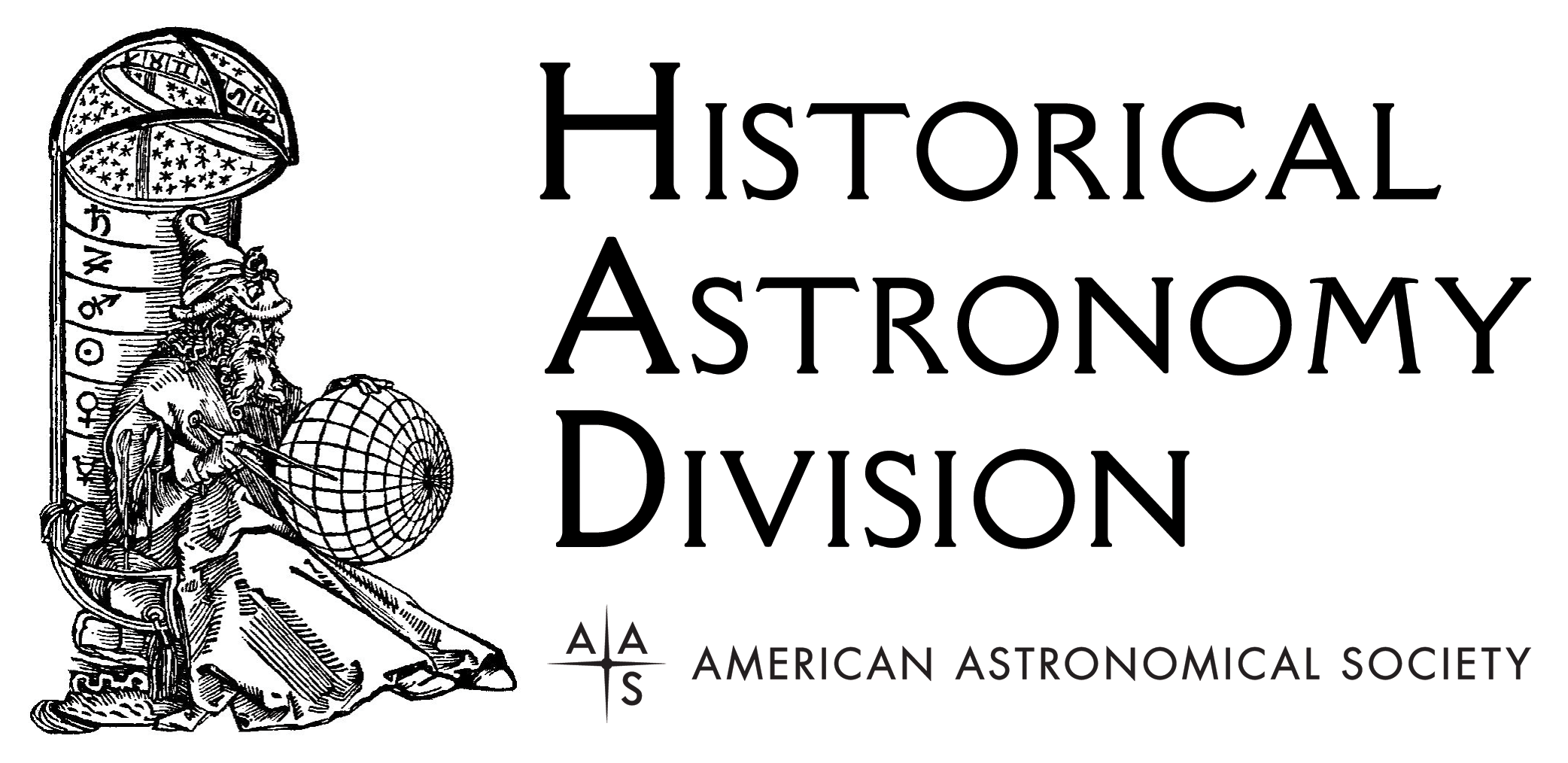 Each month as part of this series from the AAS Historical Astronomy Division (HAD), an important discovery or memorable event in the history of astronomy will be highlighted. This month, author Tom English writes about the solar eclipse of 1900. Interested in writing a short (500-word) column? Instructions along with previous history columns are available on the HAD web page.
Each month as part of this series from the AAS Historical Astronomy Division (HAD), an important discovery or memorable event in the history of astronomy will be highlighted. This month, author Tom English writes about the solar eclipse of 1900. Interested in writing a short (500-word) column? Instructions along with previous history columns are available on the HAD web page.
“The Best Place on the Face of the Earth:” Wadesboro and the 1900 Total Solar Eclipse
With two significant eclipse tracks crossing the United States next year, astronomers will be making travel plans, if not for research purposes, just for the spectacle of the event. One hundred twenty-three years ago this month, the path of totality of the solar eclipse of 28 May 1900 traversed the southern US from New Orleans to Norfolk. It inspired a coordinated effort among the American astronomical community to put as many observers (and their equipment) as possible into the shadow of the Moon.
In 1900, the AAS, then known as the Astronomical and Astrophysical Society of America, was in its infancy. One of its first committees was established by George E. Hale and Edward C. Pickering to plan for this eclipse.1 Hale, the committee’s secretary, strove to set an astrophysical observing agenda and to organize and coordinate the efforts of American eclipse parties. He sent out circulars suggesting possible observing programs, collected information from potential participants, and published this information in the Astrophysical Journal (ApJ) and elsewhere in the months leading up to the event.
One of his ApJ circulars detailed the plans of American eclipse parties, with sites spread across five states. Harvard chose an Alabama station, Lick Observatory went to Georgia, and the Naval Observatory dispatched parties to North Carolina and Georgia. Several dozen institutions put expeditions in the field, ranging from single persons with modest equipment to major undertakings that occupied large tracts of land on which tons of apparatus were assembled.2
One location, in particular, was chosen by several large parties, along with many other smaller teams. No expedition site, in 1900 or at any other nineteenth-century eclipse seen on American soil, could rival the collection of astronomers and equipment that converged on the small North Carolina town of Wadesboro in May 1900.
Two giants from the first generation of American astrophysics, Samuel P. Langley (Smithsonian Institution), and Charles A. Young (Princeton University), were there with sizable teams, and Hale brought his Yerkes Observatory group to join them.3,4,5 The British Astronomical Association (BAA) also sent a group to Wadesboro, as did many others, including Vassar, Boston University, Blue Hill Meteorological Observatory, the Coast and Geodetic Survey, and the Toronto Astronomical Association.6-12 The entire Citadel senior class traveled to Wadesboro — they had studied Young’s text in their astronomy course and were able to meet him to discuss the eclipse and his work.13
The US Weather Bureau conducted a three-year study of sky conditions along the eclipse path that influenced many parties in their choice of station.14 The data indicated clouds diminishing inland from the shorelines, with the most favorable rankings falling in Alabama and Georgia. Much of the early discussion among American astronomers centered on those states, but Wadesboro eventually emerged as the most popular destination. It had easy access to major rail and communication lines, boasted the most favorable weather rating east of Georgia, and its eastward location gave a slightly longer duration of totality and a higher sun. Young and Langley preferred to not stray too far from their east coast bases and that made the site especially favorable to them. The town enthusiastically adopted the visiting astronomers, providing free access to sites, carriage service, ample lodging options, and special events.15
Hale’s “Solar Eclipse Problems,” published in the Astrophysical Journal in January, stressed that there should “be some measure of cooperation between different parties,” and outlined a 12-point plan of suggested observations:
- Naked-eye drawings of the corona
- Drawings at the telescope
- Color of the corona and prominences
- Small-scale photographs of the corona
- Photographs of the corona during the partial phase
- Photographic search for possible intra-Mercurial planets
- Large-scale photographs of the corona and prominences
- Distribution of “coronium”
- Position of the green coronal line
- Photographs of the spectrum of the chromosphere
- Photographs of the spectrum of the corona
- Heat radiation of the corona
Hale urged his readers to study the results obtained at previous eclipses, consider the scientific questions at hand, and design their equipment and plans accordingly. He then provided several paragraphs on each point to help the intending observers prepare.16 The first half of Hale’s list was the standard plan that had been used for the past four decades, including visual and subjective methods not likely to produce strong scientific data, as well as the search for “Vulcan” — which by 1900 was believed by many to be a fruitless endeavor. The rest of the list shows the transition to Hale’s beloved astrophysics, requiring the full employment of the latest advances in photography and spectroscopy to probe the nature and structure of the corona.
With ambitious astrophysical goals for the eclipse, Yerkes and the Smithsonian sent advance teams to Wadesboro several weeks early to secure a site near the town center and to erect the station with help from local contractors.17,18 The more modest Princeton/BAA station was a few hundred yards to the east on a gently sloping eastward-facing hill. (The eclipse occurred around 8:30 am, so an open east vista was crucial.) As a testament to Hale’s efforts to build cooperation among astronomers for this eclipse, Langley obtained a 5-inch Venus Transit Refractor from the Naval Observatory for his own use, as well as a 12-inch lens of 135-foot focus from Harvard and a 5-inch lens of 38-foot focus from Princeton.19 The long-focus cameras were employed to obtain the large-format corona images Hale called for, and Yerkes had their own 61½-foot camera nearby. The Smithsonian effort also included intra-Mercurial planet cameras, a spectrograph fed by the 135-foot lens, and C. G. Abbot’s bolometer for measuring the heat of the corona.20
The Yerkes camera, an early precursor of the great solar telescope Hale would later build at Mount Wilson, was fed by a coelostat, projecting into a darkroom where George W. Ritchey operated a plate-advancing apparatus of his own construction and E. E. Barnard made the exposures. Meanwhile, E.B. Frost employed a slitless spectrograph, fed by the same coelostat, and Hale had his own bolometer experiment set up in a nearby shed.21
On the ridge to the east, Young, whose book, The Sun, was the classic compendium of solar knowledge during the era, led a Princeton group that included a young Henry Norris Russell, fresh off his dissertation defense.22 Young’s focus was on the elusive coronium, whose green spectral line he first observed in 1869; the rest of the Princeton team carried out various visual, spectroscopic, and photographic efforts, spanning Hale’s recommendations.23 Adjacent to the Princeton station was the BAA party, led by Rev. John MacKenzie Bacon, accompanied by his daughter Gertrude (the pair were noted for their aeronautical adventures), and the celebrated British magician John Nevil Maskelyne.24 The BAA observation plans were modest, save for an innovative instrument employed by Maskelyne.25
In May 2019 the Royal Astronomical Society and the British Film Institute released a restored and digitized version of a movie of the May 1900 eclipse, made by Maskelyne in Wadesboro using a device of his own construction, the kinematographic telescope.26 He captured 299 images during totality and 887 during the partial phases. The resulting film was shown with much fanfare in London later in the year but eventually faded into obscurity. Its re-emergence 119 years after it was made establishes it again as a notable first — the first successfully processed movie of an eclipse.
By all accounts, the weather in Wadesboro was ideal, as predicted, on eclipse day. Most groups in Wadesboro viewed the eclipse as a general success, especially photographically. The coronal structure visible in the large-format images made a significant impression, and such efforts became a staple of later expedition plans.
There were disappointments, though. Hale’s efforts to measure the heat of the corona met with an accident in the bolometer house at the onset of totality, and all attempts to observe the green line in the coronal spectrum failed. Young summed up his disappointment by telling a colleague “I feel like getting into a well and staying there.”27
It would be decades before coronium would be revealed to be highly ionized iron, bringing the realization that processes beyond the turn-of-the-century understanding were at play in heating the corona to million-degree temperatures. And the solution to the anomalous advance of Mercury’s perihelion that inspired so many intra-Mercurial efforts was still in the future. Nineteen years later, with the sun in a similar patch of Taurus as was seen for the 1900 eclipse, General Relativity would have its day and the matter would be laid to rest.
With the convergence of so many prominent astronomers in Wadesboro, the scale of the plans set forth on the observing grounds there, and the cinematic first at the hands of Maskelyne, the small North Carolina town deserves special recognition. It was, as one observer suggested, at least for the day of the eclipse, “the best place on the face of the Earth.”28
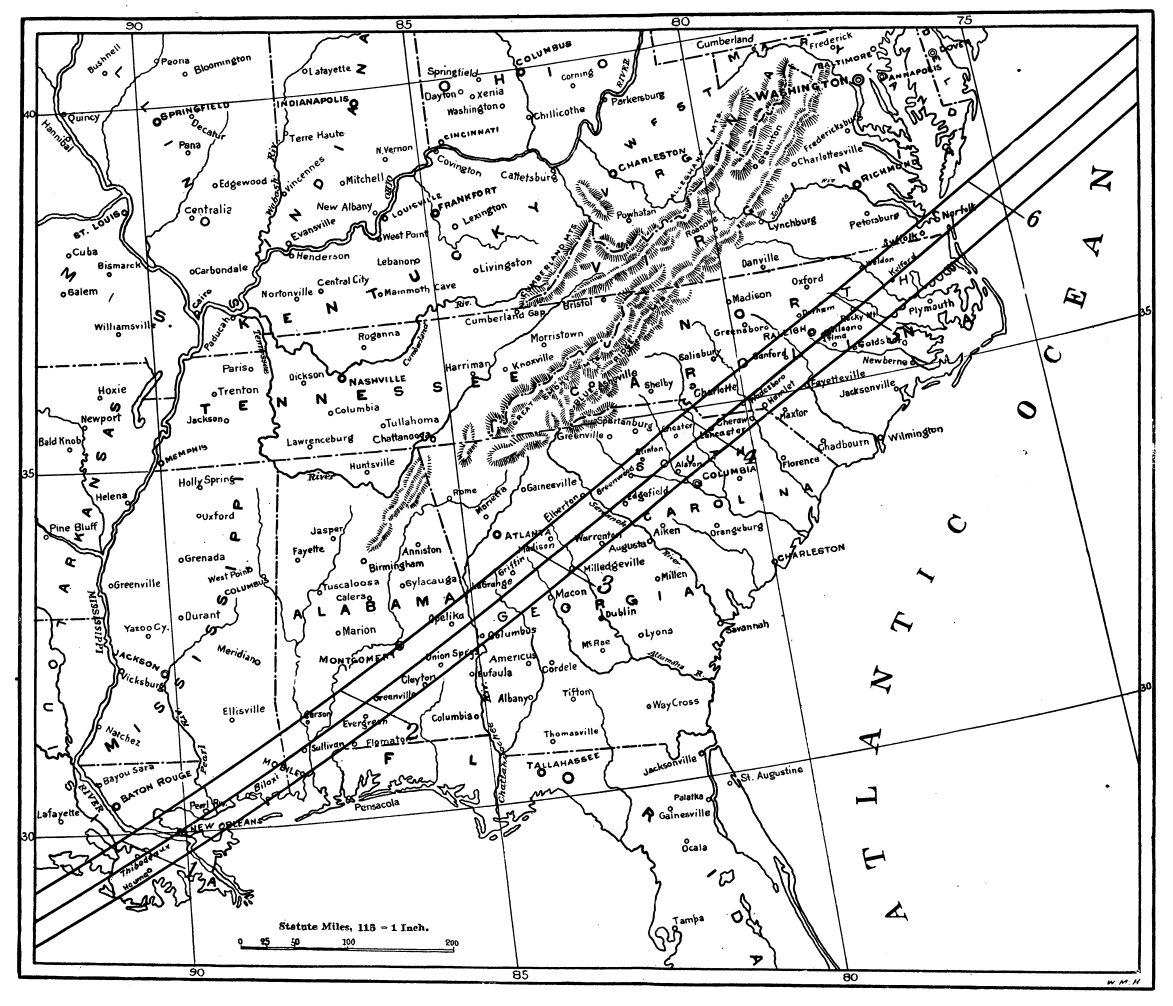
Fig. 1: Path of Totality through the Southeastern United States for the Total Solar Eclipse of 28 May 1900. Wadesboro, NC is near the center line, just north of the South Carolina Border. Credit: Wilson, Herbert C. (1900), “The Total Solar Eclipse, May 28, 1900,” Popular Astronomy, Vol. 8, p. 240, Plate X.
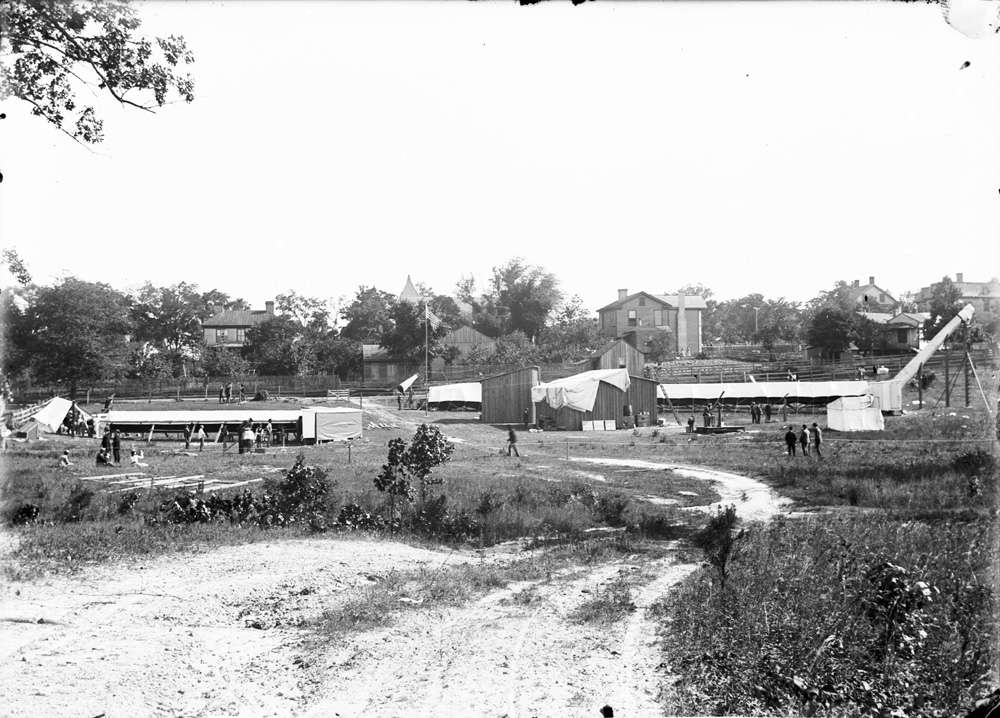
Fig. 2: The site of the Yerkes and Smithsonian expedition site for the 28 May 1900 total solar eclipse in Wadesboro, NC, facing north. Long-focus cameras with covered light tubes connecting to darkroom houses dominate the scene. The Yerkes station is to the left, with its 61 1/2 -ft camera, and the and the Smithsonian to the right, with its 135- and 38-ft cameras feeding a common photographic shed. The structures in the center are for bolometric work and additional cameras. Credit: University of Chicago Photographic Archive, apf6-03968, Hanna Holborn Gray Special Collections Research Center, University of Chicago Library.
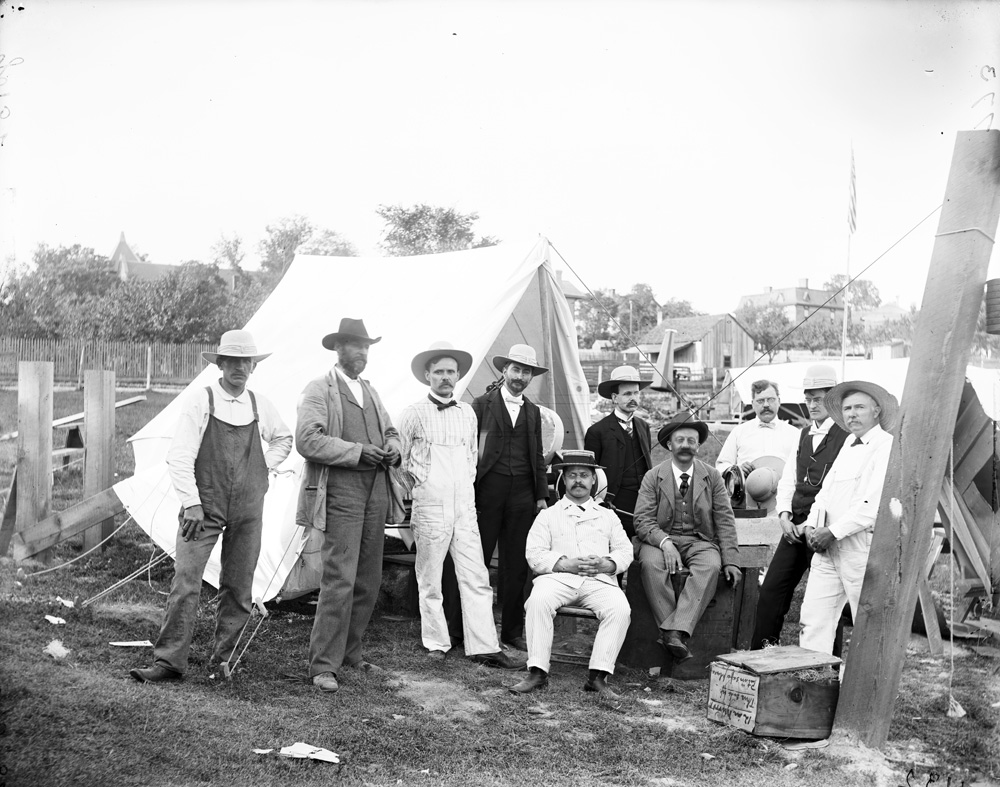
Fig. 3: The Yerkes group, gathered around the coelostat that would feed their 61½ -ft. horizontal telescope in Wadesboro. Standing, left to right: Frank Wolf, the Yerkes handyman/janitor; William Brasington, a Wadesboro contractor who provided materials and supplies; George Willis Ritchey, the telescope-maker; Hale’s right-hand man Ferdinand Ellerman; Yerkes Director George Ellery Hale; George Snow Isham, a Chicago doctor and friend of the observatory who helped finance the expedition; Edwin Brant Frost, who succeeded Hale as Yerkes Director, and Edward Emerson Barnard, the noted observer/photographer. Dutch astronomers A. A. Nijland and J. H. Wilterdink are seated at the front. They visited the Wadesboro stations on their way to Thomaston, GA, to join the Lick Observatory party on the day of the eclipse. Nijland & Wilterdink were preparing for the expedition they would lead to Sumatra in the Dutch East Indies in 1901, where totality would be a whopping 6½ minutes, compared with a minute and a half at the 1900 eclipse. Credit: University of Chicago Photographic Archive, apf6-00774, Hanna Holborn Gray Special Collections Research Center, University of Chicago Library.
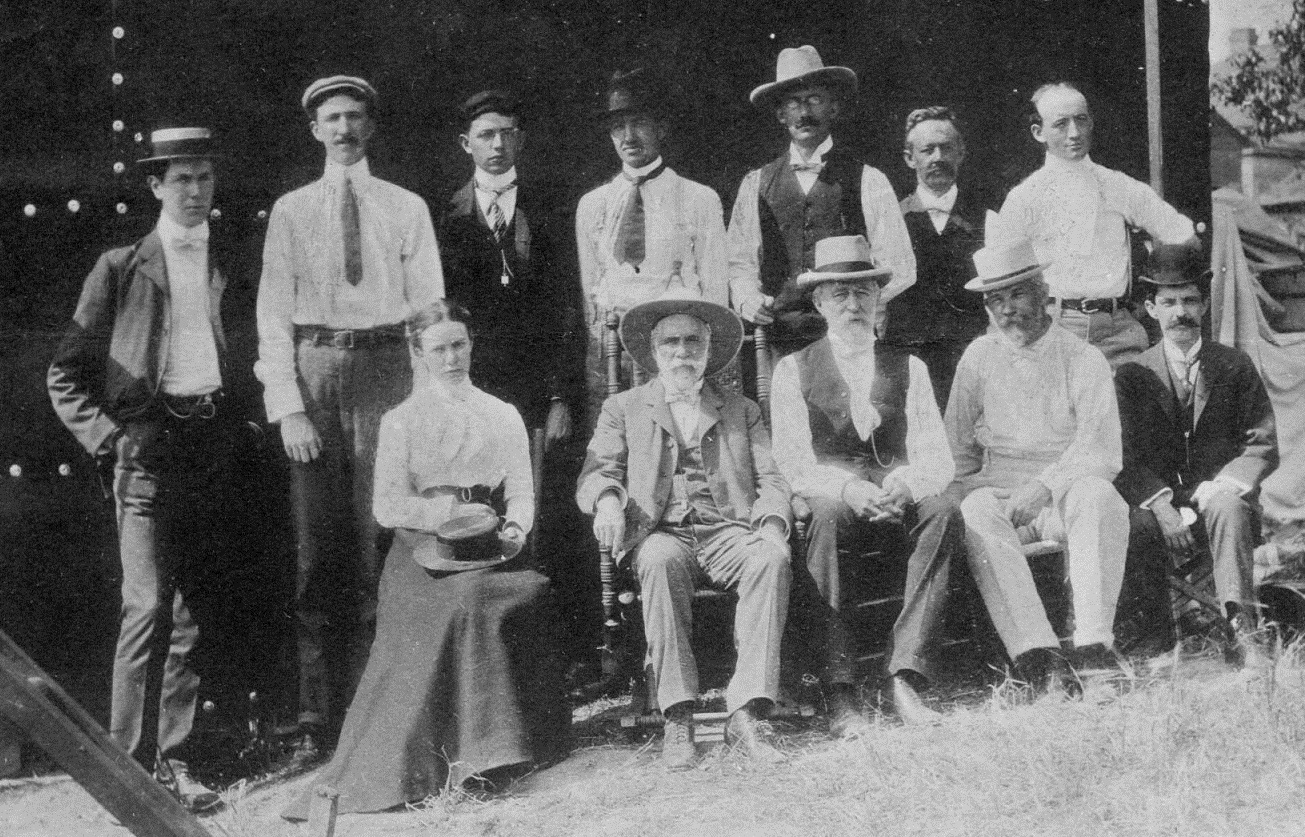
Fig. 4: Princeton Party at their station in Wadesboro. Front row (L-R): Mary Blanchard Magie, Charles Augustus Young, Cyrus Fogg Brackett, William Libbey, Dayton C. Miller; back row (L-R): Minot Morgan, John Reilly Jr., Henry Norris Russell, Taylor Reed, William Francis Magie, Frederick Fisher, Howard McClenahan. Credit: Princeton Scientific Expeditions Collection (AC012), Box 1, Folder 5.; Princeton University Archives, Department of Special Collections, Princeton University Library.
References
- “Resolutions, Committee Minutes, Signature Lists and Miscellaneous Documents, 1899-1900,” Folder 1, Box 1, Records of the American Astronomical Society, 1897-1988, Subgroup II, Series I; American Institute of Physics, Niels Bohr Library, College Park, MD, USA.
- Hale, George E. (1900). “Plans of American Eclipse Parties,” Astrophysical Journal, Vol. 11, p. 314.
- Langley, Samuel P. (1904). The 1900 Solar Eclipse Expedition of the Astrophysical Observatory of the Smithsonian Institution, GPO, Washington.
- Young, Charles A. (1900). “The Princeton Eclipse Expedition to Wadesboro’, NC, May 1900,” Princeton University Bulletin, Vol. XI (June 1900), p. 69-87.
- Hale, G. E. (1900). “The Yerkes Observatory of the University of Chicago, Bulletin No. 14, Observations of the Total Solar Eclipse of May 28, 1900, at Wadesboro, N. C.,” Astrophysical Journal, Vol. 12, p. 80.
- Bacon, John M. (1901). “Wadesborough, North Carolina” The Total Eclipse 1900: Reports of the Expeditions Organized by the British Astronomical Association to Observe the Total Solar Eclipse of 1900 May 28, E. W. Maunder, ed., Knowledge, London, 1901, p. 6-17.
- “Gathering of Famous Men,” Charlotte News, 28 May 1900, p.1.
- Whitney, Mary W. (1900). “Observations of the Total Eclipse by the Vassar College Party,” Astrophysical Journal, Vol. 12, p. 96.
- Coit, Judson B. (1900). “Observations at Wadesboro, N. C.,” Astrophysical Journal, Vol. 12, p. 97.
- Clayton, Henry H. (1901). “The Eclipse Cyclone and Diurnal Cyclones,” Annals of the Astronomical Observatory of Harvard College, Vol. 43, pt. 1, Cambridge : The Observatory, 1901.
- Putnam, George R. (1900). “Observations of the Solar Eclipse of May 28,” Astronomical Journal, Vol. 21, p. 29.
- Lindsay, Thomas (1901), “Eleventh Meeting,” Transactions of the Toronto Astronomical Society for the year 1900, Carswell, Toronto, p. 16-19.
- Smoak, William W. (1900). “Journal of William Wightman Smoak, May 26, 1900-May 27, 1900,” A1997.7, Box 1, Folder 3, The Citadel Archives and Museum.
- Bigelow, Frank H. (1899). “On the Probable State of the Sky along the Path of the Total Eclipse of the Sun, May 28 1900, Observations of 1899,” U.S. Weather Bureau, Washington.
- Medley, Mary Louise. (1976). History of Anson County, North Carolina, 1750-1976, Anson County Historical Society, 1976, p. 141-3; Bacon, “Wadesborough, North Carolina,” p. 13-14.
- Hale, George E. (1900). “Solar Eclipse Problems,” Astrophysical Journal, Vol. 11, p. 47.
- Langley, Samuel P. (1901). “Report of the Work of the Astrophysical Observatory for the Year Ending June 30, 1900,” Annual Report of the Board of Regents of the Smithsonian Institution for the Year Ending June 30 1900, GPO, Washington, p. 104.
- E. E. Barnard to G. E. Hale, 11 May 1900, Yerkes Observatory Director’s Papers, Box 17, Folder 6; G. W. Ritchey to G. E. Hale, 12 May 1900, Yerkes Observatory Director’s Papers, Box 18, Folder 2, Hanna Holborn Gray Special Collections Research Center, University of Chicago Library.
- Pickering to Langley, 9 February 1900, Smithsonian Institution Archives, Samuel P. Langley Papers, Record Unit 31, Box 24.
- Langley, Samuel P. (1904).
- Hale, G. E. (1900). ApJ, 12, 80.
- Young, Charles A. (1898). The Sun, Appleton, New York.
- Young, Charles A. (1900).
- Bacon, Gertrude. (1907). The record of an aeronaut, being the life of John M. Bacon, John Long, London.
- Bacon, John M. (1901).
- “First ever solar eclipse film brought back to life” https://ras.ac.uk/news-and-press/news/first-ever-solar-eclipse-film-bro… (accessed 8 April 2003).
- “The Eclipse at Wadesboro, N.C.”, Scientific American Supplement, No. 1275 (9 June 1900), p. 20444.
- Winston, Charles H. (1900). “Eclipse a Success,” The Richmond Dispatch, 28 May 1900, p.1.
Further Reading
Expedition reports from the 28 May 1900 eclipse available to read or download through Google Books (all accessed 9 April 2023):
- The full Smithsonian report from Wadesboro (referenced above). https://www.google.com/books/edition/The_1900_Solar_Eclipse_Expedition_of_the/WOgRAAAAYAAJ
- The full BAA report (referenced above), including the accounts of the Wadesboro party and other groups stationed on the Iberian Peninsula and in and Africa. https://www.google.com/books/edition/The_Total_Solar_Eclipse_1900/jkc6AQAAIAAJ
- The U.S. Naval Observatory’s report of the 28 May 1900 and 17 May 1901 eclipses has their full reports form Pinehurst, NC and Thomaston, GA, as well as other observers throughout the southeast. https://www.google.com/books/edition/Total_Solar_Eclipses_of_May_28_1900_and/LXzmAAAAMAAJ
- A summary of the weather study conducted for this eclipse, along with extensive observations and notes on eclipse meteorology, can be found in Eclipse Meteorology and Allied Problems, by Frank Bigelow, who observed the 1900 eclipse from Newberry, SC. https://books.google.com/books/about/Eclipse_Meteorology_and_Allied_Problems.html?id=nPXmAAAAMAAJ
For background on nineteenth century solar eclipse expeditions, see:
- Pang, Alex Soojung Kim. (2002). Empire and the Sun: Victorian Solar Eclipse Expeditions, Stanford University Press.
- Bell, Trudy. (2003). “The Victorian Space Program,” The Bent of Tau Beta Phi, Spring 2003, p. 11-18. Available online at https://www.tbp.org/pubs/Features/Sp03Bell.pdf (Accessed 9 April 2023)
A Detailed Wadesboro Timeline is available here (Conference Poster presentation by the author) https://www.researchgate.net/publication/369910999_How_Wadesboro_NC_Became_the_Station_of_Choice_for_the_Great_American_Eclipse_of_1900

